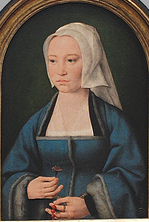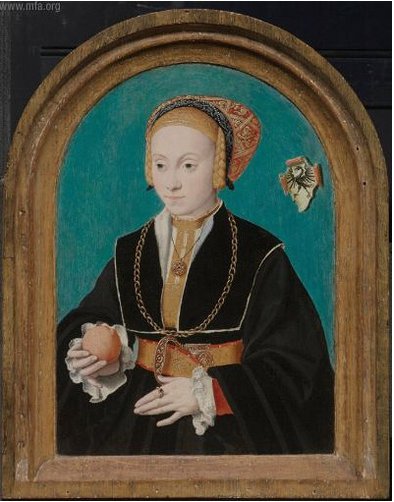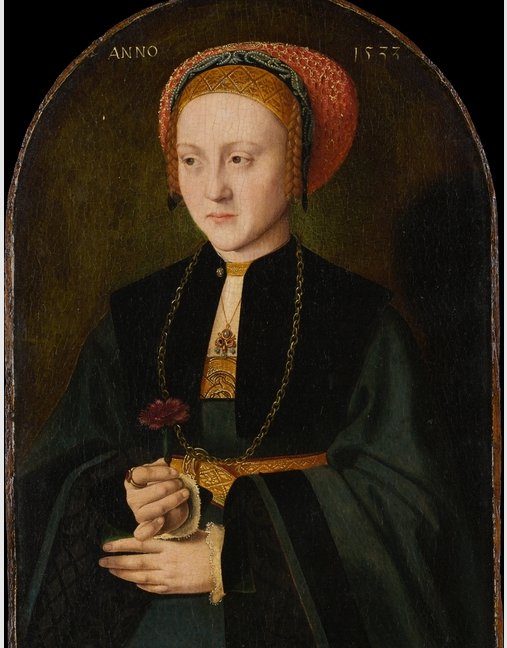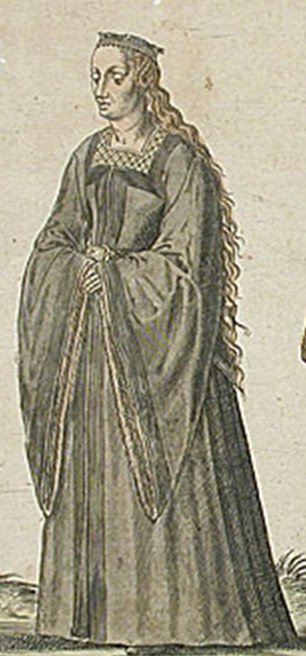The Costume of Westphalia
Written and copyright by Holly Stockley (THL Femke de Roas), The Fresian Frock Girl
The German region of Westphalia in the 16th century was located in the Northwest portion of what is modern Germany. It contains the cities of Kleves and Köln, though the borders fluctuated with the political situation that existed between the various powers. Sometimes it contained Frisia and a snippet of the Duchy of Saxony, the dress of which shows some marked similarities to the Westphalian style.
One of the best places to start demonstrating the style is with the portraits painted by Joos van Cleve. Who was,  unsurprisingly, from the city of Cleves. While he did paint some portraits for noble patrons which are in the high style of the Courts of England and Spain, he also painted local wealthy people.
unsurprisingly, from the city of Cleves. While he did paint some portraits for noble patrons which are in the high style of the Courts of England and Spain, he also painted local wealthy people.
This portrait is typical of styles of the early 16th century. The chemise has a wide, rather open neck, which appears to be gathered to its binding. The gown is blue (which seems to have been a favored color of van Cleve’s sitters). It has wide sleeves that are turned back to reveal tighter red sleeves underneath.
To the right we have another portrait, again in the favored shade of blue. This time without the contrasting red sleeves, but the color is still an excellent foil for the sitter’s complexion. This gown is more obviously fur lined, in grey. The neckline of her chemise is less visible, and a sheer v-necked partlet has been added to fill in the space. The lines of a black undergown can be seen at the sides of the neckline, as well as in the cuff of one sleeve.
of her chemise is less visible, and a sheer v-necked partlet has been added to fill in the space. The lines of a black undergown can be seen at the sides of the neckline, as well as in the cuff of one sleeve.
Two of the primary artists to study for this region are the father and son, Barthel Bruyn the elder and the younger. Bruyn the Elder was a student of van Cleve and went on to become the prominent portrait artist of the city of Köln. Unlike his master, Bruyn the Elder didn’t paint for the nobility, but rather exclusively for the wealth burgher class. As such, he tends to be more true to his subject, presenting us with a realistic likeness,  rather than an idealized form. The wealth of decoration on these costumes speaks to their wearers’ wealth.
rather than an idealized form. The wealth of decoration on these costumes speaks to their wearers’ wealth.
Here we have a portrait of Margarethe von Aich. Her chemise is high necked and trimmed with gold. The turnback sleeves and contrasting narrower undersleeve are present. But the Köln style will also start to be marked with a wide belt and elaborate head dress. Two braids are all that is visible of Margarethe’s hair – if they aren’t fake braids and a permanent part of the head piece, which is also possible. The very close match in color between braids and the front of the head dress make it seem planned, especially as the same consistency in color is seen in the next portrait, as well. There is also a partlet lined in white with the lapels turned back. A gold chain, rings, and pendant complete the impression of wealth and influence.
The next portrait, dated 1533, continues the mode of dark, sumptuous fabrics and bright gold accents. The head dress is, again, a prominent feature in the look of the sitter and an abrupt departure from the white head scarf common in the nearby Low Countries.
This lady’s gown is either covered with a partlet that tucks into the belt or has merged with it. It’s difficult to tell what’s going on behind her wide sleeves. More gold embroidery or brocade is evident – at the neck of the chemise, the top of the gown bodice, the belt, and the forehead band of the head dress. Her head dress appears to also be decorated with small pearls. The deep hunter green of the gown sets of the gold trimming and red accents very nicely. Once again, our sitter wears a heavy gold chain that is unadorned, a pendant on a lighter chain, and a ring.
bodice, the belt, and the forehead band of the head dress. Her head dress appears to also be decorated with small pearls. The deep hunter green of the gown sets of the gold trimming and red accents very nicely. Once again, our sitter wears a heavy gold chain that is unadorned, a pendant on a lighter chain, and a ring.
The sitter in the next portrait to the left actually has dark braids, indicating that at least this sitter may have her real hair displayed. This is the more likely given that her eyebrows look  dark, and a wisp of dark roots appears at her temple, just below the gold edge of the head dress as well. Her head dress is more flattened toward the back, giving a less extreme impression. Otherwise, however, the entire effect is similar to the other two.
dark, and a wisp of dark roots appears at her temple, just below the gold edge of the head dress as well. Her head dress is more flattened toward the back, giving a less extreme impression. Otherwise, however, the entire effect is similar to the other two.
Barthel Bruyn the younger continued in the pattern his father had set. He painted a large number of upper class women from Köln, though the style evolves considerable over time. It remains distinctive, however, especially in the silhouette of the gown and shape of the head dress. This lady’s gown and accessories are more elaborate than before. The turn back sleeves are deocrated with pearls, she wears more jewelry, and even the cuffs of her chemise have goldwork. Her head dress has gained a little veil-let, the braids have disappeared, and the general shape has made a move in the direction of the horned head dresses popular a century earlier. The wide gold belt appears, at least in this case, to have given way to a chain and pomander. Still, the overall effect is still clearly “Köln.”
gained a little veil-let, the braids have disappeared, and the general shape has made a move in the direction of the horned head dresses popular a century earlier. The wide gold belt appears, at least in this case, to have given way to a chain and pomander. Still, the overall effect is still clearly “Köln.”
A bit further on in time, the head dress develops in shape, and the sleeves tighten up and begin to change as well. This lady to the left has her partlet fastened all the way up, with a ruffled lining or very high-necked chemise showing underneath. Her braids ARE visible, though in a gold to match the head dress, rather than dark, as her visible roots are. The horns on the head dress reach their extreme in this incarnation. This is one of the few portraits to show the hairline, and a distinct center part, which offers a little clue to the hairstyle that might exist underneath.
The real alteration is the sleeves. It almost looks as if someone  has cut off the bottom half of her sleeves and bound them in black, though the switch from the low, set in sleeve to this very puffed one is also a major change. The belt is also gone, and the silhouette now moves into a point at the center front, suggestive of a corset. This portrait is dated 1565, and is indicative of a fashionable young woman.
has cut off the bottom half of her sleeves and bound them in black, though the switch from the low, set in sleeve to this very puffed one is also a major change. The belt is also gone, and the silhouette now moves into a point at the center front, suggestive of a corset. This portrait is dated 1565, and is indicative of a fashionable young woman.
The two styles seemed to have existed in tandem for a while, which wouldn’t be surprising. Clothing wasn’t lightly discarded, and one gown would have been worn until it was in poor enough condition to be sold or handed down. Clothing was a valued item, and often bequeathed item by item in wills.
A number of lesser artists also tended to imitate both Bruyns. The next portrait is by follower of Barthel Bruyn the Younger. This lady wears a rather extreme scarf or veil over her head dress – a feature which is not uncommon in Köln. We see more aspects of the earlier gowns here. Heavy, turn back sleeves lined with fur, wide decorative belt and heavy use of gold brocade ribbon on both chemise and bodice. However, this may well be a copy of an earlier painting, and is undated. I’d put it in with the earlier styles. The veil is a precursor for the more stylized version that comes along a little later, and so this portrait is interesting in that regard as well.
gowns here. Heavy, turn back sleeves lined with fur, wide decorative belt and heavy use of gold brocade ribbon on both chemise and bodice. However, this may well be a copy of an earlier painting, and is undated. I’d put it in with the earlier styles. The veil is a precursor for the more stylized version that comes along a little later, and so this portrait is interesting in that regard as well.
Toward the end of the century, a trend begins for “catalogs” of dress from different countries. Printed in book form, many are created by authors who never saw a lot of the costumes they are presenting in person. The various artists borrow heavily from each other and probably from other sources, especially as very remote cultures are concerned. Still, a number of them were written by Dutch and German artists, and therefore a likely to be reasonably accurate where those regions are concerned.
Abraham de Bruyn was one such author, who published a lovely  “trachtenbuch” filled with hand-tinted engravings in the 1580s. Figures are labeled by origin, and sometimes by class or other category. The Köln maiden pictured to the left is dressed in much the same manner as the portrait above. High, ruffled neck, black decorative trim, short oversleeves. There is also careful depiction of the braids incorporated into the head dress, and it’s distinct shape as well. Her costume does lack the puffed shoulders, however. The artist has depicted both the partlet and sleeves in brocade. While this is possible, I’ve yet to ever seen a portrait depicting this style with a partlet in anything other than solid black. The general impression given when viewing most trachtenbuchen is that the artists have an inordinate fondness for drawing brocade patterns. I tend to take their presence with a grain of salt.
“trachtenbuch” filled with hand-tinted engravings in the 1580s. Figures are labeled by origin, and sometimes by class or other category. The Köln maiden pictured to the left is dressed in much the same manner as the portrait above. High, ruffled neck, black decorative trim, short oversleeves. There is also careful depiction of the braids incorporated into the head dress, and it’s distinct shape as well. Her costume does lack the puffed shoulders, however. The artist has depicted both the partlet and sleeves in brocade. While this is possible, I’ve yet to ever seen a portrait depicting this style with a partlet in anything other than solid black. The general impression given when viewing most trachtenbuchen is that the artists have an inordinate fondness for drawing brocade patterns. I tend to take their presence with a grain of salt.
There is another engraving of a Köln maiden from the same manuscript, though I have never seen this particular ensemble in portrait form, either. The dress looks somewhat familiar, but the crown and other elements are a bit fanciful. This lady reminds me more than a little of the drawings and portraits of women from Nurnberg. She lacks the high-necked chemise, black partlet, and wide gold belt that seems to otherwise always accompany the wide-sleeved gown as seen in Köln. I bring it up here as an example of the occasional somewhat suspect image you may run across, especially in trachtenbuchen. This may be a real style, a depiction of an old style, or a mislabeled lady from another town entirely.
the crown and other elements are a bit fanciful. This lady reminds me more than a little of the drawings and portraits of women from Nurnberg. She lacks the high-necked chemise, black partlet, and wide gold belt that seems to otherwise always accompany the wide-sleeved gown as seen in Köln. I bring it up here as an example of the occasional somewhat suspect image you may run across, especially in trachtenbuchen. This may be a real style, a depiction of an old style, or a mislabeled lady from another town entirely.
De Bruyn’s trachtenbuch also occasionally portrays a woman specifically labeled as a “bride.” There are sometimes elements of costume associated with both married and unmarried  ladies. Also, as a wedding is a special occasion, the designator “bride” serves to tell us the lady in question is probably being painted in her best dress. Here we see the wide sleeves, black partlet, fur linings, and some indication that the underskirt is of watered silk. The head scarf here is in it’s most extreme form, with lapets wrapped around and affixed to the head.
ladies. Also, as a wedding is a special occasion, the designator “bride” serves to tell us the lady in question is probably being painted in her best dress. Here we see the wide sleeves, black partlet, fur linings, and some indication that the underskirt is of watered silk. The head scarf here is in it’s most extreme form, with lapets wrapped around and affixed to the head.
Relatively rich portrait evidence from Köln allows us to study the development of this regional style over time in a fair degree of detail. There are lots of other images available from the area and time period that are worth looking at. What is clear is that the style does evolve markedly over time, and five to ten years can profoundly change the look. Recall, as well, that both of the Bruyns specialized in the upper classes. There are fewer instances of middle and working class women available, as the trend for genre market paintings was less pronounced here.
The nearby city of Kleves, as we saw at the beginning, shared many elements of this style. We’ll head back to Kleves next, and show the similarities as that style, too, evolved.
While Kleves doesn’t seem to have had a handy-dandy pair of native painters, it did have a famous resident. And, handily, her portrait was painted repeatedly. While the portrait of Anne of Kleves by Hans Holbein is the more famous (and does, indeed, depict her in the typical Westphalian style),
 I’ve always prefered the one painted by Barthel Bruyn. She looks more content with herself, and more natural in the gown in question. Certainly, she is less stiffly posed, gazing to the viewer’s left, rather than straight ahead. All the typical features of the Köln costume are here, from the head dress, to the full sleeves, to the black partlet. Anne’s partlet appears to be trimmed with gold, and the red undergown looks like it may have pearls on the upper bodice. This, you might consider to be Anne Among Her Peers of the City.
I’ve always prefered the one painted by Barthel Bruyn. She looks more content with herself, and more natural in the gown in question. Certainly, she is less stiffly posed, gazing to the viewer’s left, rather than straight ahead. All the typical features of the Köln costume are here, from the head dress, to the full sleeves, to the black partlet. Anne’s partlet appears to be trimmed with gold, and the red undergown looks like it may have pearls on the upper bodice. This, you might consider to be Anne Among Her Peers of the City.
Its worth also looking at her other portraits. Bruyn painted a second, which is also distinctly German in style. Remember that the family of Anne of Cleves had control of a fairly wide territory, to include a section of Saxony. Her sister, Sybille, was painted by Lucas Cranach in a Saxon gown as abetrothal portrait. This portrait is more Anne as German nobility. She drips with gold and brocade, and the whole ensemble, while regional in cut, is much more complex than is typical. This is Köln style blinged out for the Court.
a section of Saxony. Her sister, Sybille, was painted by Lucas Cranach in a Saxon gown as abetrothal portrait. This portrait is more Anne as German nobility. She drips with gold and brocade, and the whole ensemble, while regional in cut, is much more complex than is typical. This is Köln style blinged out for the Court.
In 1539, Holbein painted both Anne and her sister Amelia. Anne’s brother, the Duke of Cleves, was currently wrangling with Charles V over Gelderland, making the alliance between England and Cleves seem advantageous to both sides. As it turned out, Henry was unimpressed, referring to Anne as a “Flanders Mare.” This appellation makes one wonder if Henry’s geography was a little off, or if the cultural divide between the nearby regions of Cleves, Flanders, and the northern Dutch provinces was just not that great.
Holbein painted Anne in yet another rather over-the-top version of Westphalian style. This portrait is probably the most famous of her, though Holbein has since been accused of being a little too kind to Anne as a subject.
This gown combines some of the features of the others we’ve seen.  The wide sleeves are caught up just above the elbows. Gold trim and pearls simple drip off the gown. It lacks the black partlet otherwise so ubiquitous. Its construction is a bit of a mystery, however. Is the gold section in the front with the flowers along the neckline an undergown, or something of a plastron atop the gown? This skirt appears to wrap to Anne’s left, clearly demarcated by the trim running down it’s length. None of the other portraits appear to have this feature. The head dress, as well, is unusual (which is fitting for a Duke’s sister and potential Queen). Short answer – take portraits of Anne for what they are when studying the style. There were, after all, few Duke’s sisters.
The wide sleeves are caught up just above the elbows. Gold trim and pearls simple drip off the gown. It lacks the black partlet otherwise so ubiquitous. Its construction is a bit of a mystery, however. Is the gold section in the front with the flowers along the neckline an undergown, or something of a plastron atop the gown? This skirt appears to wrap to Anne’s left, clearly demarcated by the trim running down it’s length. None of the other portraits appear to have this feature. The head dress, as well, is unusual (which is fitting for a Duke’s sister and potential Queen). Short answer – take portraits of Anne for what they are when studying the style. There were, after all, few Duke’s sisters.
It’s worthwhile to go back to de Bruyn’s trachtenbuch for more information about less noble dress in Kleves. Again, de Bruyn divides his ladies both by class and social category. First, let’s look at a Kleves matron. This lady looks very much like the ladies from Köln. The black partlet is again present, as is the shape of the head dress. Decorative black guards are feature, as are contrasting undersleeves. There appears to be a partial over skirt tied on over the top, open in front, with green ties.
as are contrasting undersleeves. There appears to be a partial over skirt tied on over the top, open in front, with green ties.
Another matron pictured by de Bruyn sports the more elaborate head scarf. The same style is seen in some of Bruyn the Younger’s portraits of upper class matrons. They appear to be made of very fine linen, carefully creased. As of the gown, the general shape and cut are consistent and familiar. Her sleves are wide,  and a decorative belt is present. Again, the outer skirt is folded away from the center to reveal both its lining and the underskirt.
and a decorative belt is present. Again, the outer skirt is folded away from the center to reveal both its lining and the underskirt.
The Westphalian style is lovely and distinctive. It can also probably be safely applied to some of the cities in the Eastern portion of the Dutch provinces, such as Nijmegen.
Later, a comparison of similarities of styles between Westphalia, Saxony, and the Northern Dutch provinces!
Photo credit: Hans Ollerman. I invite anybody with an interest in either German costuming or the art of the period in general to take a look at his delightful photostream on Flickr:
http://www.flickr.com/photos/menesje/
He also moderates a number of image sets that are pertinent as well. Enjoy, and thank you, Hans!
This article is copyright © Holly Stockley (THL Femke de Roas) and is presented on this web site with full permission from the author. This information originally appeared on the retired Fresian Frock Girl web site (http://www.insaneaboutgarb.com/friesianfrockgirl) and is being archived here for future generations of costumers and historians.
